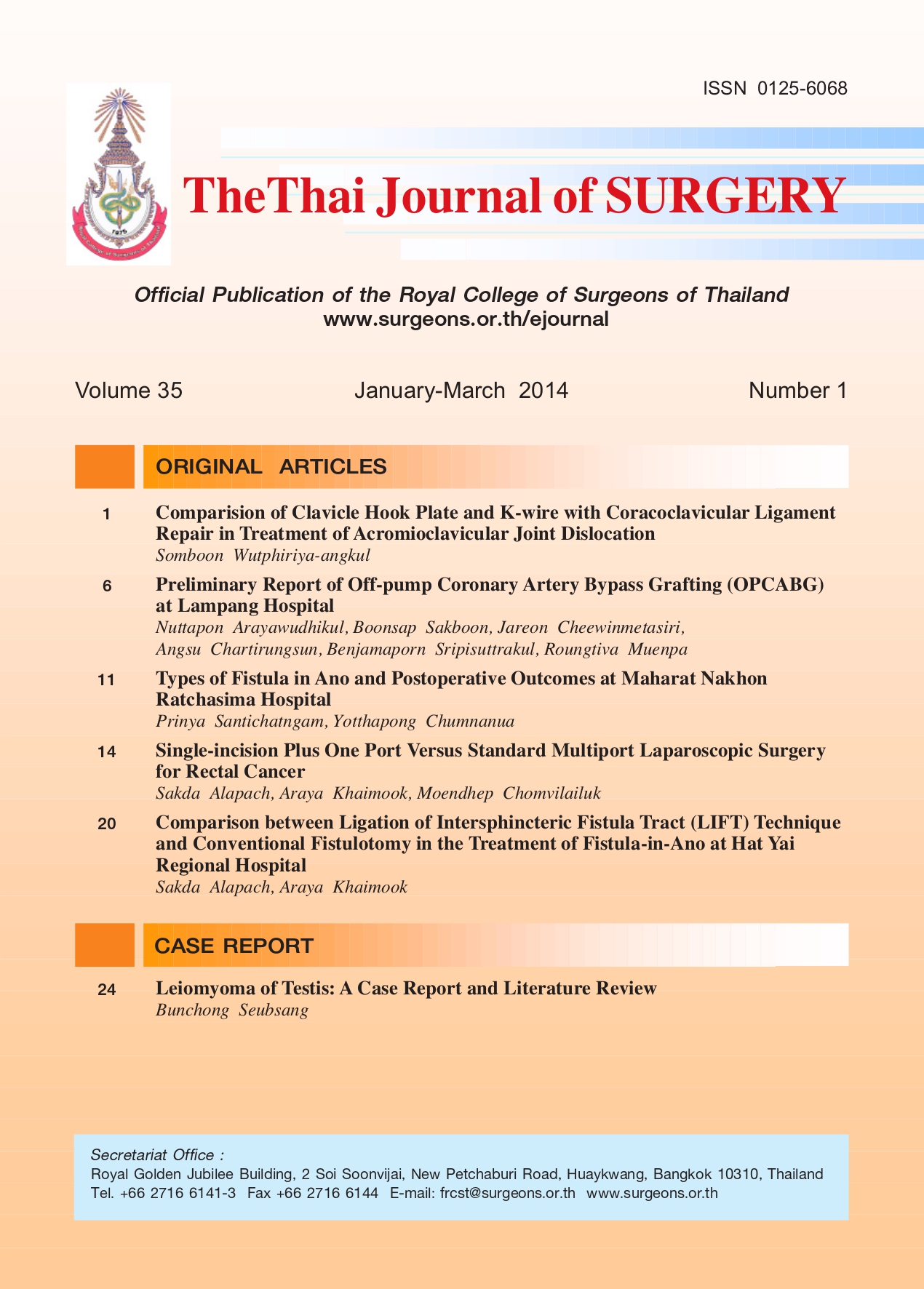Types of Fistula in Ano and Postoperative Outcomes at Maharat Nakhon Ratchasima Hospital
Keywords:
fistula in ano, type of fistula, recurrenceAbstract
Background: A fistula in ano is an abnormal tract or cavity communicating with the rectum or anal canal byidentifiable internal opening. Recurrent rates after treatment may approach 25%.
Objective: To assess the relative prevalence of each type of fistula in ano, describe intraoperative findings and
determine recurrence rate.
Patients and methods: Fistula in ano patients who underwent operation from 1 January 2009 to 31 July 2010 at
Maharat Nakhon Ratchasima Hospital were prospectively studied.
Results: There were 120 patients (101 men, 19 women), aged between 2 to 87 years (mean age 42.4 years). Fistulain-
ano was simple in 84 patients (70%) and complex in 36 patients (30%). Among the complex fistula in ano patients
were those with high transphincteric fistula in 9 cases (25%), extrasphincteric in 1 case (2.8%), anterior fistula in the
female in 7 cases (19.4%), coexistent with inflammatory bowel disease in 5 cases (13.9%), with multiple simultaneous
fistula in 10 cases (27.8%), and had prior sphincter surgeries or injuries in 4 cases (11.1%). Fistulotomy was done in
75 cases (62.5%), core out fistulectomy in 28 cases (23.3%), seton drainage in 16 cases (13.3%), advancement flap in
1 case (0.9%). Overall recurrence was 15% (18 cases). Recurrent rates were 41.7% (15 cases) in the complex fistula in
ano group and 3.6% (3 cases) in the simple fistula in ano group, which were significantly different (P <0.05).
Conclusion: Simple fistula in ano was found in 70% and complex fistula in 30% of patients. Overall recurrence
rate was 15%; for the complex fistula group the recurrence was 41.7%, which was significantly different from the simple
fistula group (3.6%).
References
of endorectal advancement flap for complex anorectal
fistulae. Am Surg 2008;74:921-4.
2. Rojanasakul A, Pattana-arun J, Sahakitrungruang C,
Tantiphlachiva K. Total anal sphincter saving technique for
fistula-in-ano; the ligation of intersphincteric fistula tract. J
Med Assoc Thai 2007;90:581-6.
3. Lilius HG. Fistula-in-ano, an investigation of human foetal anal
ducts and intramuscular glands and a clinical study of 150
patients. Acta Chir Scand Suppl 1969;383:7-88.
4. The Standards Practice Task Force of the American Society of
Colon and Rectal Surgeons. Practice parameters for treatment
of fistula-in-ano supporting documentation. Dis Colon Rectum
1996;39:1363-72.
5. Seow-Choen F, Nicholls FJ. Anal fistula. Br J Surg 1992;79:197-
205.
6. Parks AG, Gordon PH, Hardcastle JD. A classification of fistulain-
ano. Br J Surg 1976;63:1-12.
7. Goldberg SM, Garcia-Aguilar J. The cutting seton. In: Phillips
RKS, Lunniss PJ, editors. Anal Fistula. London: Chapman & Hall
Medical; 1996. p. 95-102.
8. Gurer A, Ozlem N, Gokakin AK, Ozdogan M, Kulacoglu H,
Aydin R. A novel material in seton treatment of fistula-in-ano.
Am J Surg 2007;193:794-6.
9. Deeba S, Aziz O, Sains PS, Darzi A. Fistula-in-ano: advances in
treatment. Am J Surg 2008;196:95-9.
10. Sileri P, Cadeddu F, D’Ugo S, et al. Surgery for fistula-in-ano in
a specialist colorectal unit: a critical appraisal. BMC
Gastroenterol 2011;11:111-20.
11. Abcarian H, Dodi G, Gironi J, et al. Fistula-in-ano. Int J Colorect
Dis 1987;2:51-71.
12. Christensen A, Nilas L, Christiansen J. Treatment of transphincteric
anal fistulas by the seton technique. Dis Colon Rectum
1986;29:454-5.
13. Chung W, Kazemi P, Ko D, et al. Anal fistula plug and fibrin glue
versus conventional treatment in repair of complex anal
fistulas. Am J Surg 2009;197:604-8.
14. KyAJ, Sylla P, Steinhagen R, Steingagen E, Khaitov S, Ly EK.
Collagen fistula plug for the treatment of anal fistulas. Dis
Colon Rectum 2008;51:838-43.
15. Mitalas LE, Gosselink MP, Oom DM, Zimmermen DD, Schouten
WR. Required length of follow-up after transanal advancement
flap repair of high transsphincteric fistulas. Colorectal Dis
2009;11:726-8.
16. Sygut A, Zajdel R, Kedzia-Budziewska R, Trzcinski R, Dziki A. Late
results of treatment of anal fistulas. Colorectal Dis 2007;9:151-
8.
17. Whiteford MH, Kilkenny J 3rd, Hyman N, et al. Practice
parameters for the treatment of perianal abscess and fistulain-
ano(revised). Dis Colon Rectum 2005;48:1337-42.
18. Cox SW, Senagore AJ, Luchtefeld MA, Mazier WP. Outcome
after incision and drainage with fistulotomy for ischiorectal
abscess. Am Surg 1997;63:686-9.
19. Ho YH, Tan M, Leong AF, Seow-Choen F. Marsupialization of
fistulotomy wounds improves healing: a randomized controlled
trial. Br J Surg 1998;85:105-7.
20. Garcia-Aguilar J, Belmonte C, Wong WD, Goldberg SM, Madoff
RD. Anal fistula surgery. Factors associated with recurrence
and incontinence. Dis Colon Rectum 1996;39:723-9.
21. Hammond TM, Knowles GH, Porrett T, Lunniss PJ. The Sung
Seton: short and medium term results of slow fistulotomy for
idiopathic anal fistulae. Colorectal Dis 2006;8:328-37.
Downloads
Published
How to Cite
Issue
Section
License
Articles must be contributed solely to The Thai Journal of Surgery and when published become the property of the Royal College of Surgeons of Thailand. The Royal College of Surgeons of Thailand reserves copyright on all published materials and such materials may not be reproduced in any form without the written permission.



